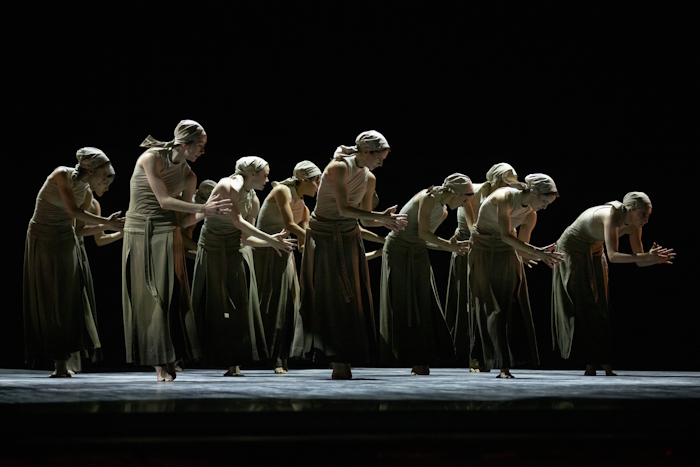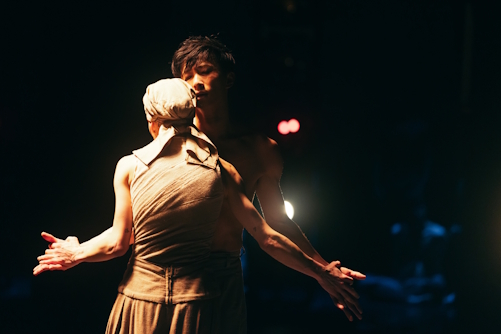September 16, 2025
New York City Center
New York City Center’s 22nd Fall for Dance season, where this season every ticket in the house costs just $23 at the box office ($30 online), got underway with an ode to the artform, former Alvin Ailey Resident Choreographer Jamar Roberts’ Dance Is A Mother. There’s no narrative, just an attractively crafted set of dances to live music by Caroline Shaw, played beautifully on stage by the Attacca Quartet, joined by vocalist Raquel Acevedo Klien.
Roberts’ choreography is not remotely bravura, not what you would call exciting. But it’s classy and holds the attention throughout, flowing pleasingly and never feeling rushed. There’s much leading with the shoulder and lifting of knees as the fine cast of Jeroboam Bozeman and Jacquelin Harris (previously of Alvin Ailey), Anna Greenberg (formerly Miami City Ballet), Sara Mearns (New York City Ballet principal) and Roberts himself swirl, twist and turn, swoop and pause. In the ensemble moments, dancers come together and part. The mood and pace never change much, even in the solos, duets and trios that pepper the piece.
Roberts may be better known as a choreographer these days, but he remains a fine dancer, unsurprisingly looking totally at one with his movement vocabulary. He and Bozeman perform a powerful side-by-side duet. Late a solo full of fluid turns stands out. And then there’s his closing duet with Mearns, undoubtedly the work’s highlight.
That duet is slow and lyrical, the pair as one before it ends a little surprisingly. Following a lift, Roberts lowers Mearns and leaves. After a slow, thoughtful arabesque, she brushes her hand on the floor, then looks left and right. Which way to go? Follow him or her own path? After a brief second to think, she chooses the latter.
It was right that Mearns should have that final moment because, as impressive as the others were, it was she who constantly drew the eye. Her movement always appeared to have that extra layer of depth and meaning, always appeared to be saying something. She gets plenty of joyful moments but, perhaps reflecting the dancer’s life with its times of struggle too, there’s contemplation too. Sometimes not moving, or just a turn of the head, a look, speaks very loudly indeed.
With choreography by Michelle Dorrance and solo performer Dario Natarelli, The Man I Love is a tap sketch to a transcription of George and Ira Gershwin’s well-known tune for live cello, played by Derek Louie. The dance is initially dreamy but develops into an impressive outburst of high-speed fireworks. But while passionate the pyrotechnics may have been, they seemed to have little connection to the music itself.
Rounding the evening off in style, San Francisco Ballet gave the New York premiere of Akram Khan’s Dust, created for English National Ballet in 2014 as part of Lest We Forget, a programme of ballets commemorating the First World War. Set against a backdrop of the trenches and images of men going ‘over the top’, it remains incredibly haunting.
Khan first shows the men leaving for war, his choreography full of anxiety. After the men slowly climb and disappear into the muddy backdrop, the women come to the fore, the powerful dance speaking about their empowerment, recognising how they stepped into roles traditionally held by men. The enthralling movement, a fusion of contemporary dance and Khan’s own kathak, and sometimes floor-based, is fast-paced strong and precise. Largely danced in unison, the togetherness was terrific.
The long, closing duet, performed in part to a recording of a song Jocelyn Pook composed based on the poem ‘In Flanders Fields’, screams loss and despair. Katherine Barkman appears in denial about the loss of her returned ghostly partner, Wei Wang. She pushes him away yet, you sense, equally wants to cling on and not let go. Greif is evident but there’s a lot of love there too. And most of all, it begs the question, was it all really necessary. The City Center audience was totally rapt. You could have heard a pin drop.
Next year, Birmingham Royal Ballet are bringing back what many see as the ultimate anti-war ballet, The Green Table. Dust, in its own way, is just as powerful.





